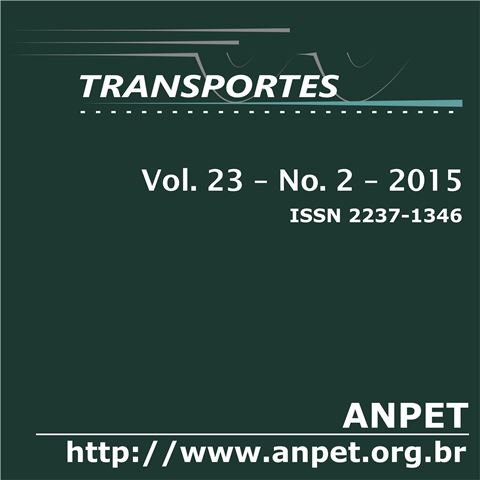.
DOI:
https://doi.org/10.14295/transportes.v23i2.880Keywords:
Pavement recycling, Portland cement, Asphalt emulsion.Abstract
This paper analyses the mechanical behavior of a Full Depth Reclamation (FDR) pavement recycled with two different stabilized agents. The material from FDR process was collected at the BR-116 roadway, near the city of Pelotas, southern of Brazil. This granular material consists by the asphalt surface and part of the granular base course. Portland cement and asphalt emulsion have been used as stabilizing agents in order to improve the mechanical behavior of the mixture. The experimental study revealed that Portland cement promoted higher values of RM (Resilient Modulus) in comparison to asphalt emulsion plus Portland cement additions. Notwithstanding, mixtures prepared only with asphalt emulsion have presented slight increase on cyclic triaxial RM, resulting, therefore, in a more ductile mix in comparison to those with Portland cement only.Downloads
References
ABNT. Associação Brasileira de Normas Técnicas. NBR 11579. Cimento Portland — Determinação do índice de finura por meio da peneira 75 μm. Rio de Janeiro: Associação Brasileira de Nor-mas Técnicas, 2012, p. 4.
ABNT. Associação Brasileira de Normas Técnicas. NBR 16018. Misturas asfálticas – Determinação da rigidez por compressão diametral sob carga repetida. Rio de Janeiro: Associação Brasileira de Normas Técnicas, 2011, p. 12.
ABNT. Associação Brasileira de Normas Técnicas. NBR 14491. Emulsões asfálticas - Determinação da viscosidade Saybolt Furol. Rio de Janeiro: Associação Brasileira de Normas Técnicas, 2007, p. 8.
ABNT. Associação Brasileira de Normas Técnicas. NBR 6568. Emulsões asfálticas - Determinação do resíduo de destilação. Rio de Janeiro: Associação Brasileira de Normas Técnicas, 2005, p. 5.
Bernucci, L. B. et al. Pavimentação asfáltica: formação básica para engenheiros. Rio de Janeiro, 2008. Petrobrás: ABEDA. p. 504.
Bonfim, V. Fresagem de pavimentos asfálticos. São Paulo: Ed. Exceção, 3.ed, 2010, p.127.
Brito, L. A. T.; Ceratti, J. A. P.; Victorino, D. R. Indicadores do Desempenho de Misturas Asfálticas Determinados Através do Ensaio de Compressão Diametral. Revista Transportes. v. 16, n. 1, p.36-44, 2008. DOI: dx.doi.org/10.14295/transportes.v.16i1.10
Costa, C.; Pinto, S. O uso de reciclagem de pavimentos como alternativa para o desenvolvimento sustentável em obras rodoviá-rias no Brasil. São Paulo: Revista Engenharia, 602.ed, 2011. p. 96-102.
Croteau, J. M.; Lee, S. Q. S. Cold In-Place Recycling: Perfor-mance And Practices. In: XIIIth IRF World Meeting. Toronto/ Canada, 1997. p. 13. Disponível em: library.tac-atc.ca/proceedings/1997/08_0519.pdf> Acesso em (30/06/2015).
Cunha, C. M. Reciclagem de Pavimentos Rodoviários Flexíveis Diferentes Tipos de Reciclagem. Dissertação (Mestrado) - Instituto Superior de Engenharia de Lisboa: Departamento de Engenharia Civil, 2010. p.110.
BRASIL. Departamento Nacional de Infraestrutura de Transpor-tes. DNIT IPR – 720/06. Manual de restauração de pavimentos asfálticos. Rio de Janeiro, 2.ed, 2006, p. 313. Disponível em: www1.dnit.gov.br/ipr_new/..%5Carquivos_internet%5Cipr%5Ci
pr_new%5Cmanuais%5CManual_de_Restauracao.pdf> Acesso em (30/06/15).
________. DNIT 167/2013-ES. Pavimentação – Reciclagem profunda de pavimentos “in situ” com adição de cimento Portland – Especificação de Serviço, 2013, p.11. Disponível em: ipr.dnit.gov.br/normas/DNIT167_2013_ES.pdf> Acesso em: (30/06/2015).
________. DNIT 136/2010-ME. Pavimentação asfáltica - Misturas asfálticas – Determinação da resistência à tração por compressão diametral – Método de ensaio, 2010, p. 6. Disponível em: ipr.dnit.gov.br/normas/DNIT136_2010_ME.pdf> Acesso em (30/06/15).
Fu, P.; Jones, D.; Harvey, J. T. The effects of asphalt binder and granular material characteristics on foamed asphalt mix strength. Construction and Building Materials. n. 25, 2011. p. 1093–1101. DOI: dx.doi.org/10.1016/j.conbuildmat.2010.06.067
Franco, F. A. C. P. Método de dimensionamento mecanístico-empírico de pavimentos asfálticos – SisPav. Tese (Doutorado) – Universidade Federal do Rio de Janeiro, Rio de Janeiro, 2007. Disponível em: www.p.coc.ufrj.br/teses/doutorado/geotecnia/2007/Teses/FRANCO_FACP_07_t_D_geo.pdf> Acesso em (30/06/2015).
Kavussi, A.; Modarres, A. Laboratory fatigue models for recycled mixes with bitumen emulsion and cement. Construction and Building Materials. 2010, n. 24, p. 1920–1927. DOI: dx.doi.org/10.1016/j.conbuildmat.2010.04.009
Marmitt, H. M.; Casagrande, M. D. T.; Ceratti, J. A. P. Caracte-rização de propriedades resilientes de três britas graduadas utilizadas em pavimentos no sul do Brasil. Teoria e Prática na Enge-nharia Civil, 2010, n. 15, p.63-69. Disponível em: www.editoradunas.com.br/revistatpec/Art7_N15.pdf> Acesso em (30/06/2015)
Motta, L. M. et al. In: 16º Encontro de Asfalto do Instituto Brasi-leiro de Petróleo. Trecho de reciclagem a frio na BR-393 – Avaliação após 8 anos da implantação. IBP03102, Anais. Rio de Janeiro, 2002.
Niazi, Y; JalilI. M. Effect of Portland cement and lime additives on properties of cold in-place recycled mixtures with asphalt emulsion. Construction and Building Materials, 2009, n. 23, p. 1338–1343. DOI: dx.doi.org/10.1016/j.conbuildmat.2008.07.020
PCA – Portland Cement Association. Full-Depth Reclamation: Recycling roads save money and natural resources, 2005. p.6. Disponível em: <http://www.roadrecycling.org/SR995.PDF> Acesso em (30/06/2015)
Ponte, R. S.; Branco, V. T. F. C.; Holanda, A. S.; SoareS, J. B. Avaliação de diferentes metodologias para obtenção do Módulo de Resiliência de misturas asfálticas. Revista Transportes. v. 22, n. 2, 2014. p. 85-94. DOI: dx.doi.org/10.14295/transportes.v22i2.792
Puppala, A. J.; Hoyos, L. R.; Potturi, A. K. Resilient Moduli Response of Moderately Cement-Treated Reclaimed Asphalt Pavement Aggregates. Journal of Materials in Civil Engineering – ASCE. v. 23, n. 7, 2011. p. 990-998. DOI: dx.doi.org/10.1061/(ASCE)MT.1943-5533.0000268
Specht, L. P.; Pires, G. M.; Vitorello, T.; Hirsh, F.; Cronst, F.; Bergmann, E.; Tiefensee, M. D. Utilização de material fresado como camada de pavimento: estudo laboratorial e aplicação em campo. In: 42ª Reunião Anual de Pavimentação. Rio de Janeiro: ABPv, 2013. 12 p.
Suleiman, N. A State-of-the-Art Review of Cold in-Place Recycling of Asphalt Pavements in the Northern Plains Region. Final Report. FHWA, 2002. 102 p. Disponível em: www.dot.nd.gov/divisions/materials/research_project/und
final.pdf . Acesso em (30/06/2015).
Taha, R.; AI-Harthy, A.; Ai-ShamsI, K.; Ai-Zubeidi, M. Cement Stabilization of Reclaimed Asphalt Pavement Aggregate for Road Bases and Subbases. Journal of Materials in Civil Engineering – ASCE. v. 14, n. 3, 2002. p. 239-245. DOI: dx.doi.org/10.1061/(ASCE)0899-1561(2002)14:3(239)
Trichês, G.; Santos, A. Desempenho da Reciclagem Com Adição de Cimento da Rodovia SC 150. In: 42 RAP, 2013, Gramado. In: 42ª Reunião Anual de Pavimentação, 2013, Rio de Janeiro: ABP v. 12.
________. Avaliação do Desempenho da Reciclagem do Pavi-mento da Rodovia SC 303. In. 7º Congresso Brasileiro de Rodo-vias e Concessões, 2011, Foz do Iguaçu. p.15.
Downloads
Published
How to Cite
Issue
Section
License
Authors who submit papers for publication by TRANSPORTES agree to the following terms:
- The authors retain the copyright and grant Transportes the right of first publication of the manuscript, without any financial charge, and waive any other remuneration for its publication by ANPET.
- Upon publication by Transportes, the manuscript is automatically licensed under the Creative Commons License CC BY 4.0 license. This license permits the work to be shared with proper attribution to the authors and its original publication in this journal, and to be adapted for non-commercial purposes, provided appropriate credit is given and any derivative works are distributed under the same terms.
- Authors are authorized to enter into additional separate contracts for the non-exclusive distribution of the version of the manuscript published in this journal (e.g., publishing in an institutional repository or as a book chapter), with recognition of the initial publication in this journal, provided that such a contract does not imply an endorsement of the content of the manuscript or the new medium by ANPET.
- Authors are permitted and encouraged to publish and distribute their work online (e.g., in institutional repositories or on their personal websites) after the editorial process is complete. As Transportes provides open access to all published issues, authors are encouraged to use links to the DOI of their article in these cases.
- Authors guarantee that they have obtained the necessary authorization from their employers for the transfer of rights under this agreement, if these employers hold any copyright over the manuscript. Additionally, authors assume all responsibility for any copyright infringements by these employers, releasing ANPET and Transportes from any responsibility in this regard.
- Authors assume full responsibility for the content of the manuscript, including the necessary and appropriate authorizations for the disclosure of collected data and obtained results, releasing ANPET and Transportes from any responsibility in this regard.









